Analyzing Ideologies in Australian Education and Children's Outcomes
VerifiedAdded on 2023/01/11
|15
|4244
|23
Report
AI Summary
This report delves into the influence of ideologies on the Australian education system, focusing on nationalism, liberalism, and conservatism. It examines the historical context and development of these ideologies, their core tenets, and their effects on curriculum, governance, and student outcomes. The report provides a comparative analysis, highlighting both the positive and negative aspects of each ideology, such as the promotion of national identity versus potential for exclusion, the emphasis on individual freedoms versus potential for social inequality, and the preservation of traditional values versus resistance to change. Furthermore, it assesses the impact of these ideologies on the current Australian education system, considering curriculum design, teaching practices, and student experiences. Finally, the report offers recommendations for integrating these ideologies in a balanced manner to foster a comprehensive and effective educational environment that supports children's learning and development, while also considering their cultural and socioeconomic backgrounds.
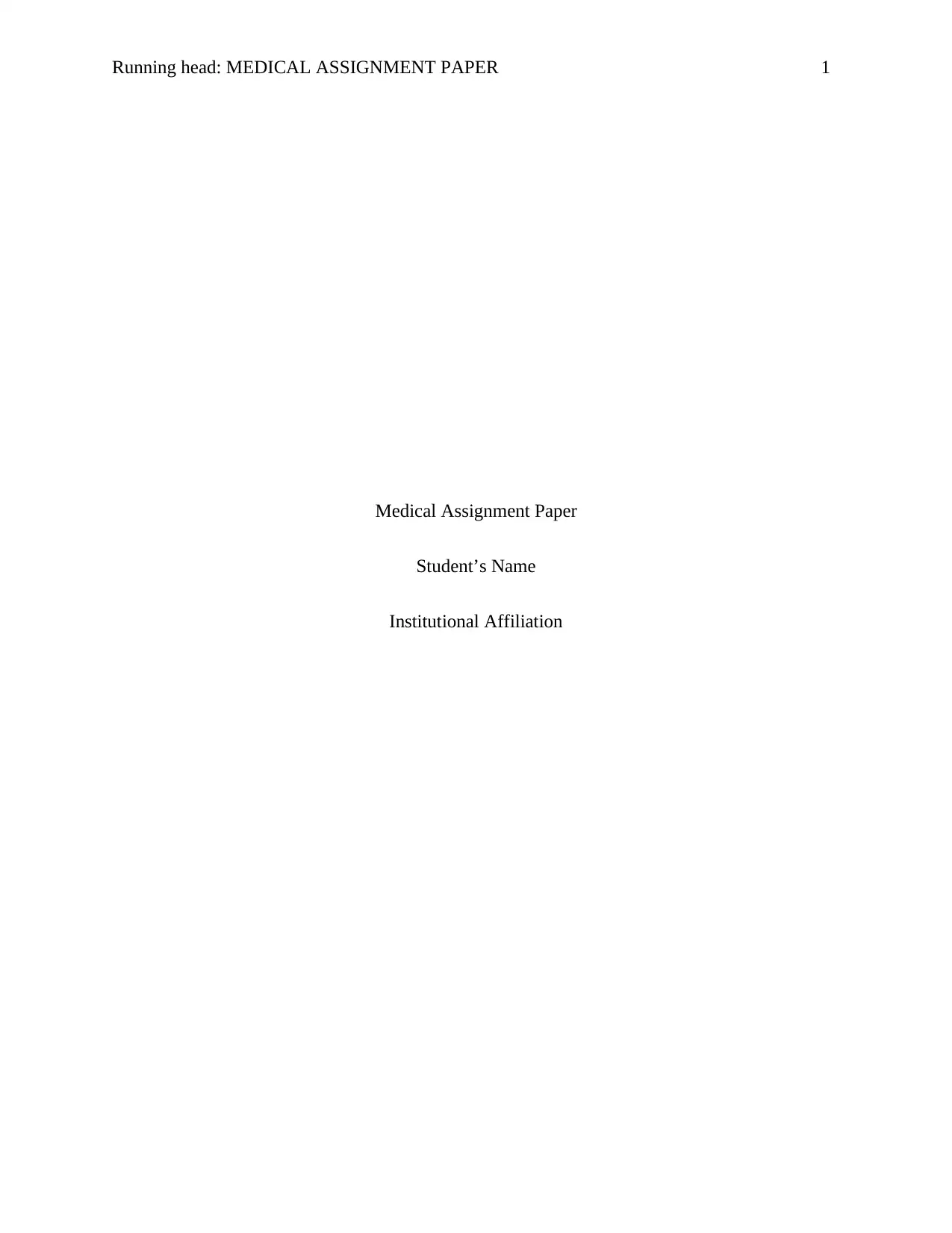
Running head: MEDICAL ASSIGNMENT PAPER 1
Medical Assignment Paper
Student’s Name
Institutional Affiliation
Medical Assignment Paper
Student’s Name
Institutional Affiliation
Paraphrase This Document
Need a fresh take? Get an instant paraphrase of this document with our AI Paraphraser
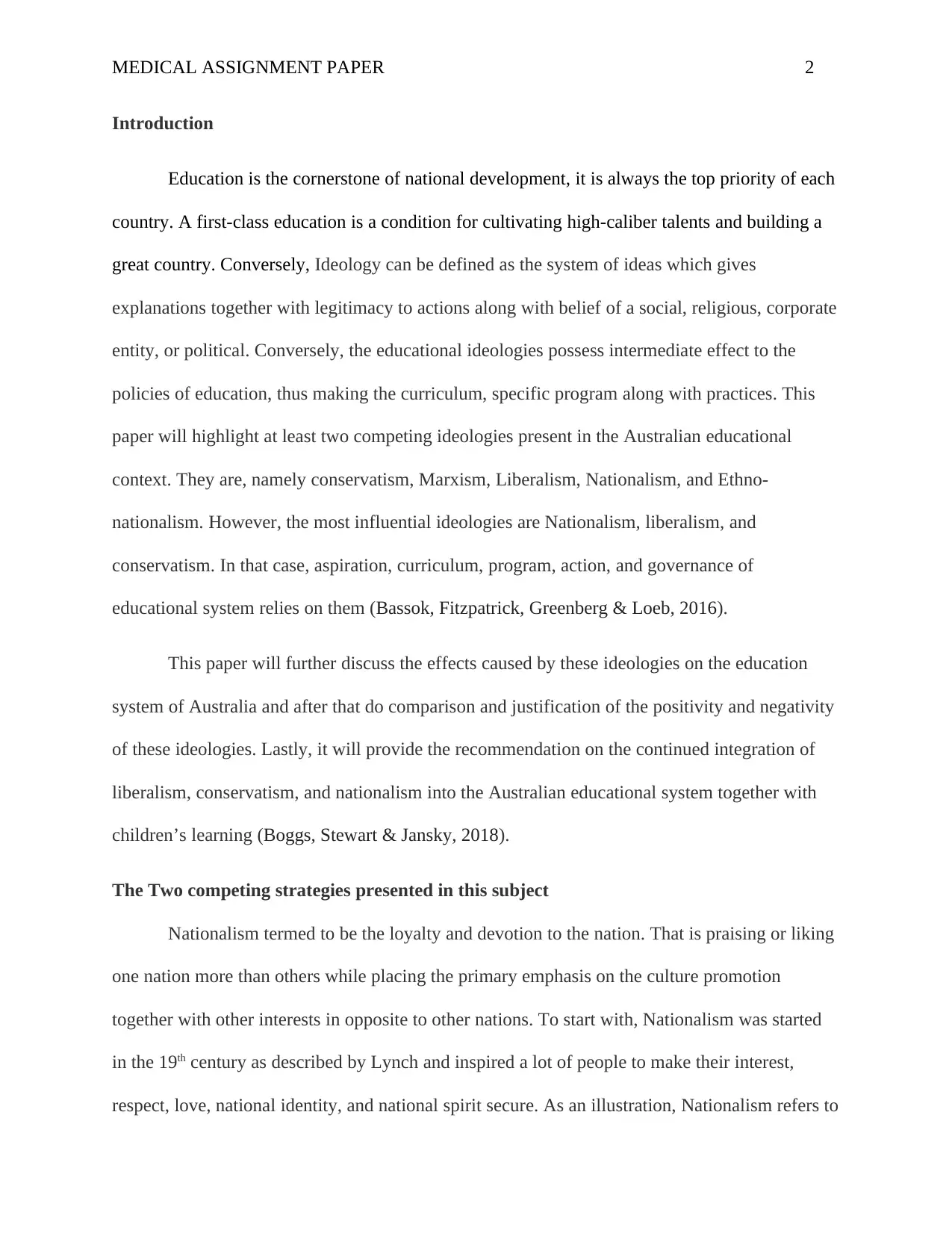
MEDICAL ASSIGNMENT PAPER 2
Introduction
Education is the cornerstone of national development, it is always the top priority of each
country. A first-class education is a condition for cultivating high-caliber talents and building a
great country. Conversely, Ideology can be defined as the system of ideas which gives
explanations together with legitimacy to actions along with belief of a social, religious, corporate
entity, or political. Conversely, the educational ideologies possess intermediate effect to the
policies of education, thus making the curriculum, specific program along with practices. This
paper will highlight at least two competing ideologies present in the Australian educational
context. They are, namely conservatism, Marxism, Liberalism, Nationalism, and Ethno-
nationalism. However, the most influential ideologies are Nationalism, liberalism, and
conservatism. In that case, aspiration, curriculum, program, action, and governance of
educational system relies on them (Bassok, Fitzpatrick, Greenberg & Loeb, 2016).
This paper will further discuss the effects caused by these ideologies on the education
system of Australia and after that do comparison and justification of the positivity and negativity
of these ideologies. Lastly, it will provide the recommendation on the continued integration of
liberalism, conservatism, and nationalism into the Australian educational system together with
children’s learning (Boggs, Stewart & Jansky, 2018).
The Two competing strategies presented in this subject
Nationalism termed to be the loyalty and devotion to the nation. That is praising or liking
one nation more than others while placing the primary emphasis on the culture promotion
together with other interests in opposite to other nations. To start with, Nationalism was started
in the 19th century as described by Lynch and inspired a lot of people to make their interest,
respect, love, national identity, and national spirit secure. As an illustration, Nationalism refers to
Introduction
Education is the cornerstone of national development, it is always the top priority of each
country. A first-class education is a condition for cultivating high-caliber talents and building a
great country. Conversely, Ideology can be defined as the system of ideas which gives
explanations together with legitimacy to actions along with belief of a social, religious, corporate
entity, or political. Conversely, the educational ideologies possess intermediate effect to the
policies of education, thus making the curriculum, specific program along with practices. This
paper will highlight at least two competing ideologies present in the Australian educational
context. They are, namely conservatism, Marxism, Liberalism, Nationalism, and Ethno-
nationalism. However, the most influential ideologies are Nationalism, liberalism, and
conservatism. In that case, aspiration, curriculum, program, action, and governance of
educational system relies on them (Bassok, Fitzpatrick, Greenberg & Loeb, 2016).
This paper will further discuss the effects caused by these ideologies on the education
system of Australia and after that do comparison and justification of the positivity and negativity
of these ideologies. Lastly, it will provide the recommendation on the continued integration of
liberalism, conservatism, and nationalism into the Australian educational system together with
children’s learning (Boggs, Stewart & Jansky, 2018).
The Two competing strategies presented in this subject
Nationalism termed to be the loyalty and devotion to the nation. That is praising or liking
one nation more than others while placing the primary emphasis on the culture promotion
together with other interests in opposite to other nations. To start with, Nationalism was started
in the 19th century as described by Lynch and inspired a lot of people to make their interest,
respect, love, national identity, and national spirit secure. As an illustration, Nationalism refers to
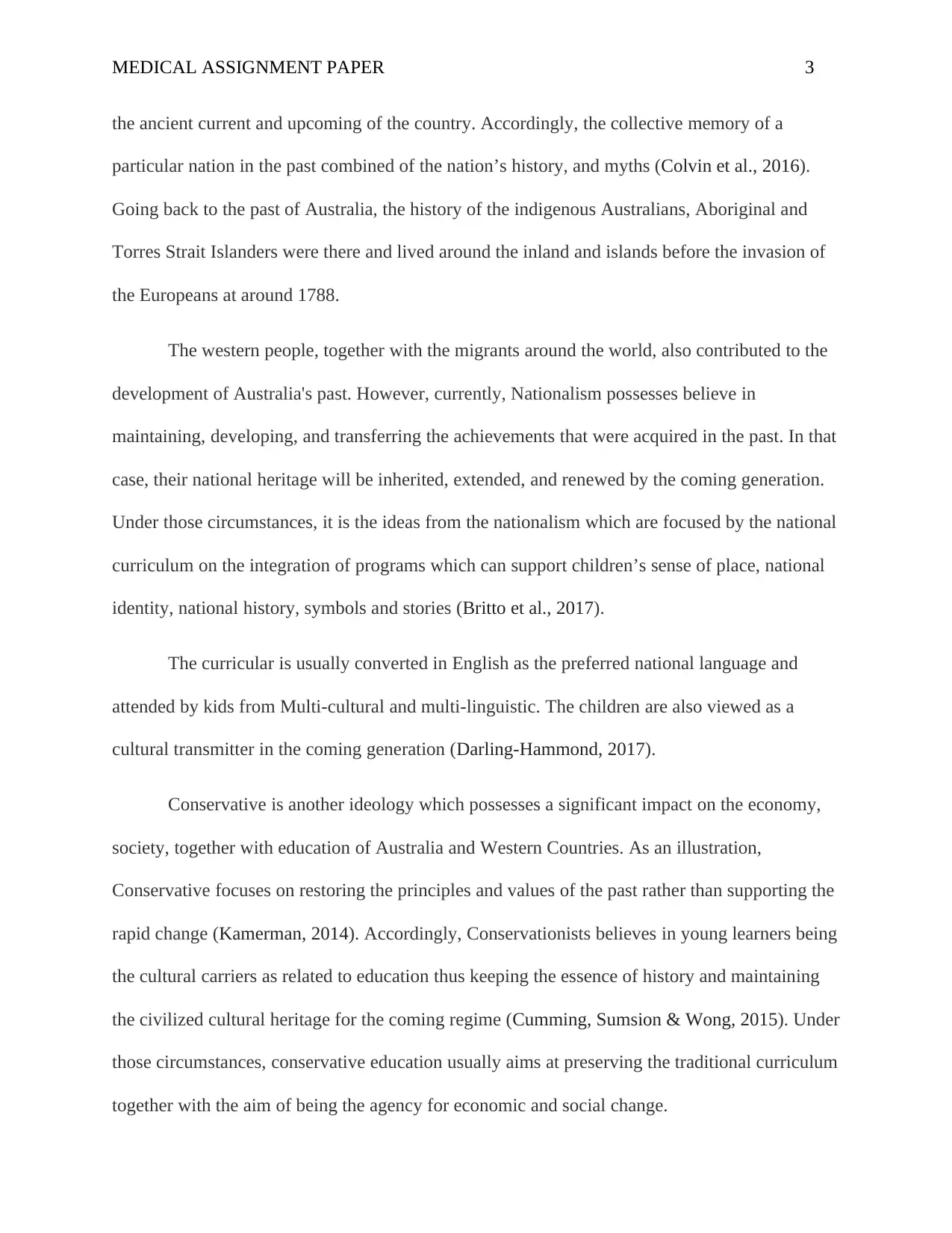
MEDICAL ASSIGNMENT PAPER 3
the ancient current and upcoming of the country. Accordingly, the collective memory of a
particular nation in the past combined of the nation’s history, and myths (Colvin et al., 2016).
Going back to the past of Australia, the history of the indigenous Australians, Aboriginal and
Torres Strait Islanders were there and lived around the inland and islands before the invasion of
the Europeans at around 1788.
The western people, together with the migrants around the world, also contributed to the
development of Australia's past. However, currently, Nationalism possesses believe in
maintaining, developing, and transferring the achievements that were acquired in the past. In that
case, their national heritage will be inherited, extended, and renewed by the coming generation.
Under those circumstances, it is the ideas from the nationalism which are focused by the national
curriculum on the integration of programs which can support children’s sense of place, national
identity, national history, symbols and stories (Britto et al., 2017).
The curricular is usually converted in English as the preferred national language and
attended by kids from Multi-cultural and multi-linguistic. The children are also viewed as a
cultural transmitter in the coming generation (Darling-Hammond, 2017).
Conservative is another ideology which possesses a significant impact on the economy,
society, together with education of Australia and Western Countries. As an illustration,
Conservative focuses on restoring the principles and values of the past rather than supporting the
rapid change (Kamerman, 2014). Accordingly, Conservationists believes in young learners being
the cultural carriers as related to education thus keeping the essence of history and maintaining
the civilized cultural heritage for the coming regime (Cumming, Sumsion & Wong, 2015). Under
those circumstances, conservative education usually aims at preserving the traditional curriculum
together with the aim of being the agency for economic and social change.
the ancient current and upcoming of the country. Accordingly, the collective memory of a
particular nation in the past combined of the nation’s history, and myths (Colvin et al., 2016).
Going back to the past of Australia, the history of the indigenous Australians, Aboriginal and
Torres Strait Islanders were there and lived around the inland and islands before the invasion of
the Europeans at around 1788.
The western people, together with the migrants around the world, also contributed to the
development of Australia's past. However, currently, Nationalism possesses believe in
maintaining, developing, and transferring the achievements that were acquired in the past. In that
case, their national heritage will be inherited, extended, and renewed by the coming generation.
Under those circumstances, it is the ideas from the nationalism which are focused by the national
curriculum on the integration of programs which can support children’s sense of place, national
identity, national history, symbols and stories (Britto et al., 2017).
The curricular is usually converted in English as the preferred national language and
attended by kids from Multi-cultural and multi-linguistic. The children are also viewed as a
cultural transmitter in the coming generation (Darling-Hammond, 2017).
Conservative is another ideology which possesses a significant impact on the economy,
society, together with education of Australia and Western Countries. As an illustration,
Conservative focuses on restoring the principles and values of the past rather than supporting the
rapid change (Kamerman, 2014). Accordingly, Conservationists believes in young learners being
the cultural carriers as related to education thus keeping the essence of history and maintaining
the civilized cultural heritage for the coming regime (Cumming, Sumsion & Wong, 2015). Under
those circumstances, conservative education usually aims at preserving the traditional curriculum
together with the aim of being the agency for economic and social change.
⊘ This is a preview!⊘
Do you want full access?
Subscribe today to unlock all pages.

Trusted by 1+ million students worldwide
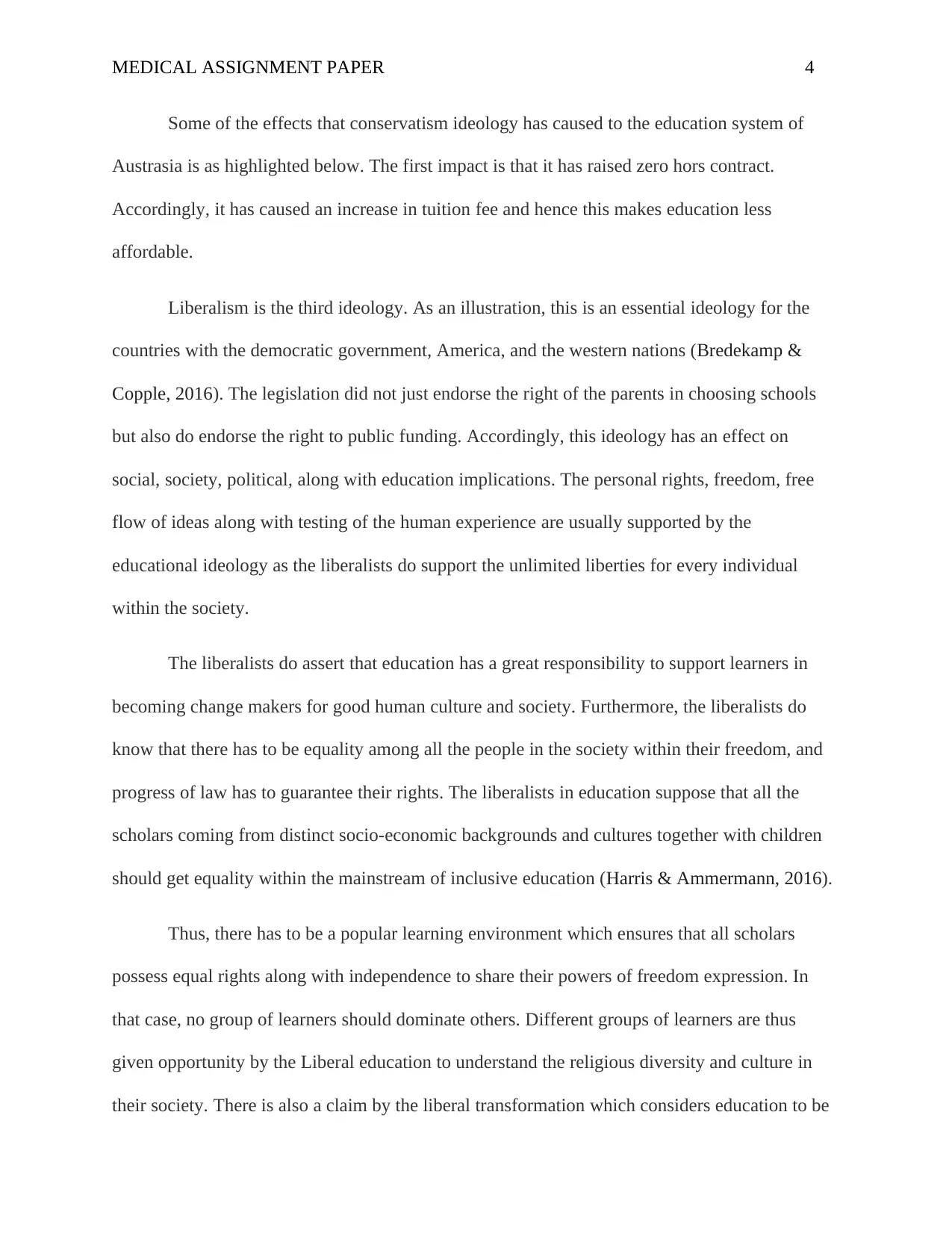
MEDICAL ASSIGNMENT PAPER 4
Some of the effects that conservatism ideology has caused to the education system of
Austrasia is as highlighted below. The first impact is that it has raised zero hors contract.
Accordingly, it has caused an increase in tuition fee and hence this makes education less
affordable.
Liberalism is the third ideology. As an illustration, this is an essential ideology for the
countries with the democratic government, America, and the western nations (Bredekamp &
Copple, 2016). The legislation did not just endorse the right of the parents in choosing schools
but also do endorse the right to public funding. Accordingly, this ideology has an effect on
social, society, political, along with education implications. The personal rights, freedom, free
flow of ideas along with testing of the human experience are usually supported by the
educational ideology as the liberalists do support the unlimited liberties for every individual
within the society.
The liberalists do assert that education has a great responsibility to support learners in
becoming change makers for good human culture and society. Furthermore, the liberalists do
know that there has to be equality among all the people in the society within their freedom, and
progress of law has to guarantee their rights. The liberalists in education suppose that all the
scholars coming from distinct socio-economic backgrounds and cultures together with children
should get equality within the mainstream of inclusive education (Harris & Ammermann, 2016).
Thus, there has to be a popular learning environment which ensures that all scholars
possess equal rights along with independence to share their powers of freedom expression. In
that case, no group of learners should dominate others. Different groups of learners are thus
given opportunity by the Liberal education to understand the religious diversity and culture in
their society. There is also a claim by the liberal transformation which considers education to be
Some of the effects that conservatism ideology has caused to the education system of
Austrasia is as highlighted below. The first impact is that it has raised zero hors contract.
Accordingly, it has caused an increase in tuition fee and hence this makes education less
affordable.
Liberalism is the third ideology. As an illustration, this is an essential ideology for the
countries with the democratic government, America, and the western nations (Bredekamp &
Copple, 2016). The legislation did not just endorse the right of the parents in choosing schools
but also do endorse the right to public funding. Accordingly, this ideology has an effect on
social, society, political, along with education implications. The personal rights, freedom, free
flow of ideas along with testing of the human experience are usually supported by the
educational ideology as the liberalists do support the unlimited liberties for every individual
within the society.
The liberalists do assert that education has a great responsibility to support learners in
becoming change makers for good human culture and society. Furthermore, the liberalists do
know that there has to be equality among all the people in the society within their freedom, and
progress of law has to guarantee their rights. The liberalists in education suppose that all the
scholars coming from distinct socio-economic backgrounds and cultures together with children
should get equality within the mainstream of inclusive education (Harris & Ammermann, 2016).
Thus, there has to be a popular learning environment which ensures that all scholars
possess equal rights along with independence to share their powers of freedom expression. In
that case, no group of learners should dominate others. Different groups of learners are thus
given opportunity by the Liberal education to understand the religious diversity and culture in
their society. There is also a claim by the liberal transformation which considers education to be
Paraphrase This Document
Need a fresh take? Get an instant paraphrase of this document with our AI Paraphraser
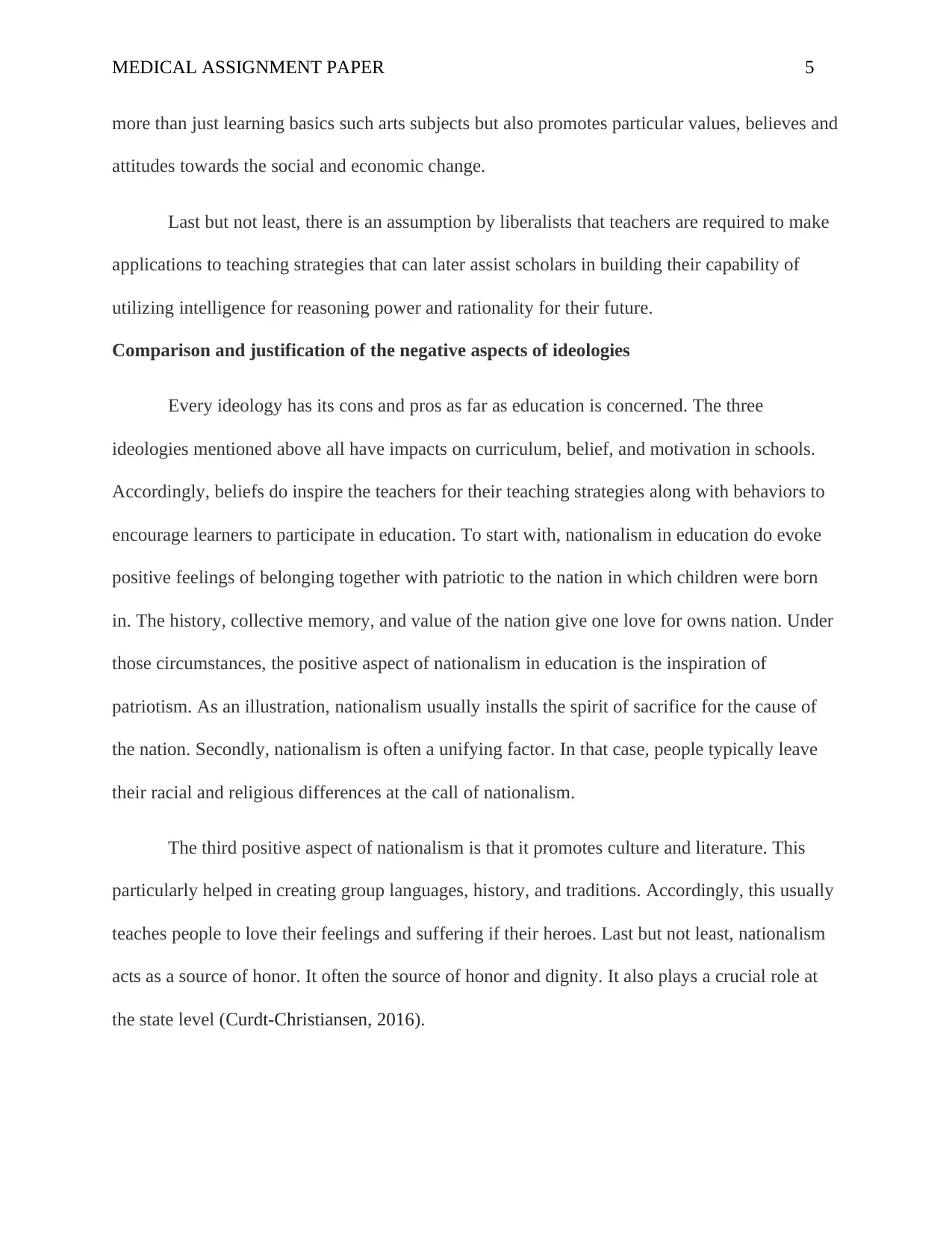
MEDICAL ASSIGNMENT PAPER 5
more than just learning basics such arts subjects but also promotes particular values, believes and
attitudes towards the social and economic change.
Last but not least, there is an assumption by liberalists that teachers are required to make
applications to teaching strategies that can later assist scholars in building their capability of
utilizing intelligence for reasoning power and rationality for their future.
Comparison and justification of the negative aspects of ideologies
Every ideology has its cons and pros as far as education is concerned. The three
ideologies mentioned above all have impacts on curriculum, belief, and motivation in schools.
Accordingly, beliefs do inspire the teachers for their teaching strategies along with behaviors to
encourage learners to participate in education. To start with, nationalism in education do evoke
positive feelings of belonging together with patriotic to the nation in which children were born
in. The history, collective memory, and value of the nation give one love for owns nation. Under
those circumstances, the positive aspect of nationalism in education is the inspiration of
patriotism. As an illustration, nationalism usually installs the spirit of sacrifice for the cause of
the nation. Secondly, nationalism is often a unifying factor. In that case, people typically leave
their racial and religious differences at the call of nationalism.
The third positive aspect of nationalism is that it promotes culture and literature. This
particularly helped in creating group languages, history, and traditions. Accordingly, this usually
teaches people to love their feelings and suffering if their heroes. Last but not least, nationalism
acts as a source of honor. It often the source of honor and dignity. It also plays a crucial role at
the state level (Curdt-Christiansen, 2016).
more than just learning basics such arts subjects but also promotes particular values, believes and
attitudes towards the social and economic change.
Last but not least, there is an assumption by liberalists that teachers are required to make
applications to teaching strategies that can later assist scholars in building their capability of
utilizing intelligence for reasoning power and rationality for their future.
Comparison and justification of the negative aspects of ideologies
Every ideology has its cons and pros as far as education is concerned. The three
ideologies mentioned above all have impacts on curriculum, belief, and motivation in schools.
Accordingly, beliefs do inspire the teachers for their teaching strategies along with behaviors to
encourage learners to participate in education. To start with, nationalism in education do evoke
positive feelings of belonging together with patriotic to the nation in which children were born
in. The history, collective memory, and value of the nation give one love for owns nation. Under
those circumstances, the positive aspect of nationalism in education is the inspiration of
patriotism. As an illustration, nationalism usually installs the spirit of sacrifice for the cause of
the nation. Secondly, nationalism is often a unifying factor. In that case, people typically leave
their racial and religious differences at the call of nationalism.
The third positive aspect of nationalism is that it promotes culture and literature. This
particularly helped in creating group languages, history, and traditions. Accordingly, this usually
teaches people to love their feelings and suffering if their heroes. Last but not least, nationalism
acts as a source of honor. It often the source of honor and dignity. It also plays a crucial role at
the state level (Curdt-Christiansen, 2016).
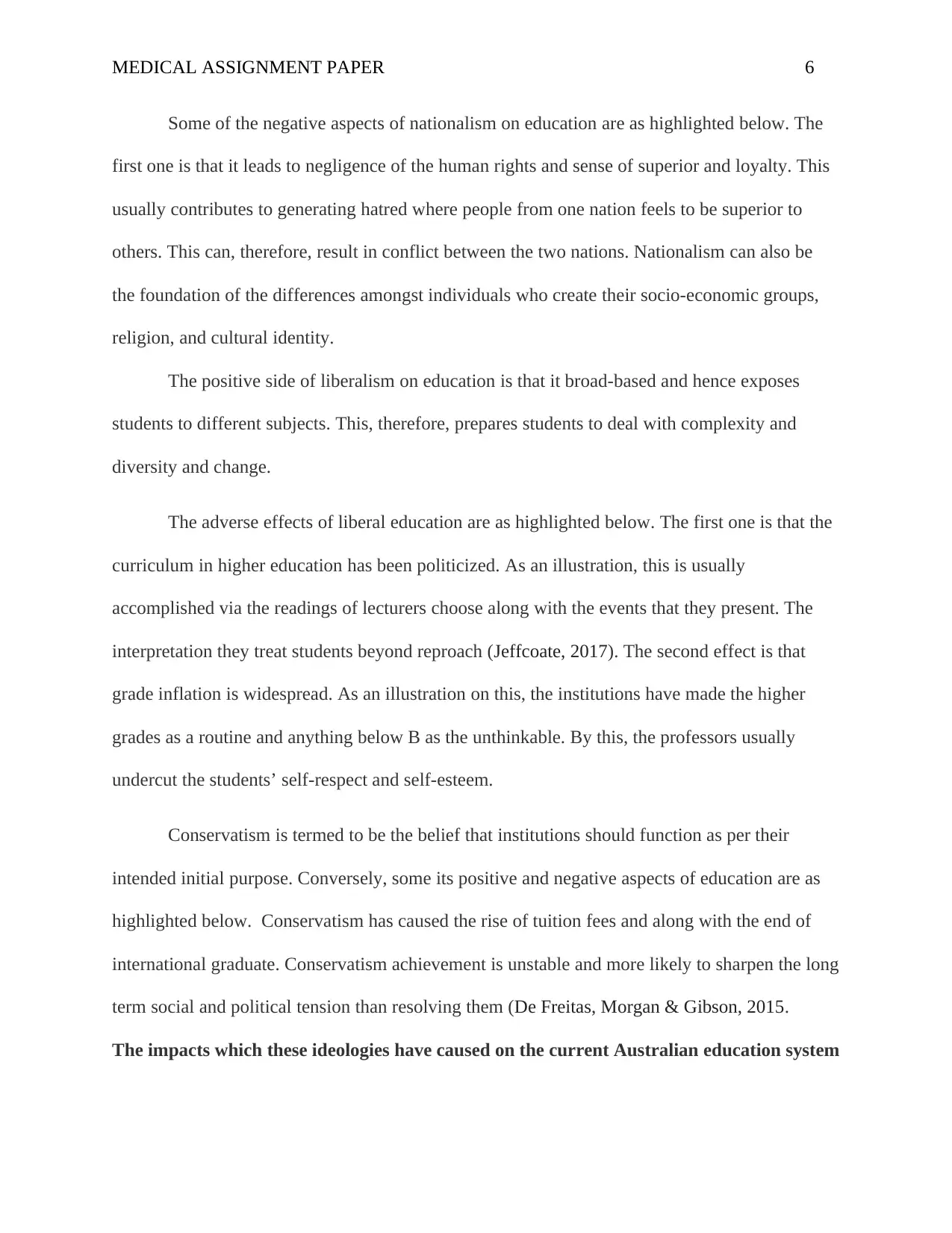
MEDICAL ASSIGNMENT PAPER 6
Some of the negative aspects of nationalism on education are as highlighted below. The
first one is that it leads to negligence of the human rights and sense of superior and loyalty. This
usually contributes to generating hatred where people from one nation feels to be superior to
others. This can, therefore, result in conflict between the two nations. Nationalism can also be
the foundation of the differences amongst individuals who create their socio-economic groups,
religion, and cultural identity.
The positive side of liberalism on education is that it broad-based and hence exposes
students to different subjects. This, therefore, prepares students to deal with complexity and
diversity and change.
The adverse effects of liberal education are as highlighted below. The first one is that the
curriculum in higher education has been politicized. As an illustration, this is usually
accomplished via the readings of lecturers choose along with the events that they present. The
interpretation they treat students beyond reproach (Jeffcoate, 2017). The second effect is that
grade inflation is widespread. As an illustration on this, the institutions have made the higher
grades as a routine and anything below B as the unthinkable. By this, the professors usually
undercut the students’ self-respect and self-esteem.
Conservatism is termed to be the belief that institutions should function as per their
intended initial purpose. Conversely, some its positive and negative aspects of education are as
highlighted below. Conservatism has caused the rise of tuition fees and along with the end of
international graduate. Conservatism achievement is unstable and more likely to sharpen the long
term social and political tension than resolving them (De Freitas, Morgan & Gibson, 2015.
The impacts which these ideologies have caused on the current Australian education system
Some of the negative aspects of nationalism on education are as highlighted below. The
first one is that it leads to negligence of the human rights and sense of superior and loyalty. This
usually contributes to generating hatred where people from one nation feels to be superior to
others. This can, therefore, result in conflict between the two nations. Nationalism can also be
the foundation of the differences amongst individuals who create their socio-economic groups,
religion, and cultural identity.
The positive side of liberalism on education is that it broad-based and hence exposes
students to different subjects. This, therefore, prepares students to deal with complexity and
diversity and change.
The adverse effects of liberal education are as highlighted below. The first one is that the
curriculum in higher education has been politicized. As an illustration, this is usually
accomplished via the readings of lecturers choose along with the events that they present. The
interpretation they treat students beyond reproach (Jeffcoate, 2017). The second effect is that
grade inflation is widespread. As an illustration on this, the institutions have made the higher
grades as a routine and anything below B as the unthinkable. By this, the professors usually
undercut the students’ self-respect and self-esteem.
Conservatism is termed to be the belief that institutions should function as per their
intended initial purpose. Conversely, some its positive and negative aspects of education are as
highlighted below. Conservatism has caused the rise of tuition fees and along with the end of
international graduate. Conservatism achievement is unstable and more likely to sharpen the long
term social and political tension than resolving them (De Freitas, Morgan & Gibson, 2015.
The impacts which these ideologies have caused on the current Australian education system
⊘ This is a preview!⊘
Do you want full access?
Subscribe today to unlock all pages.

Trusted by 1+ million students worldwide
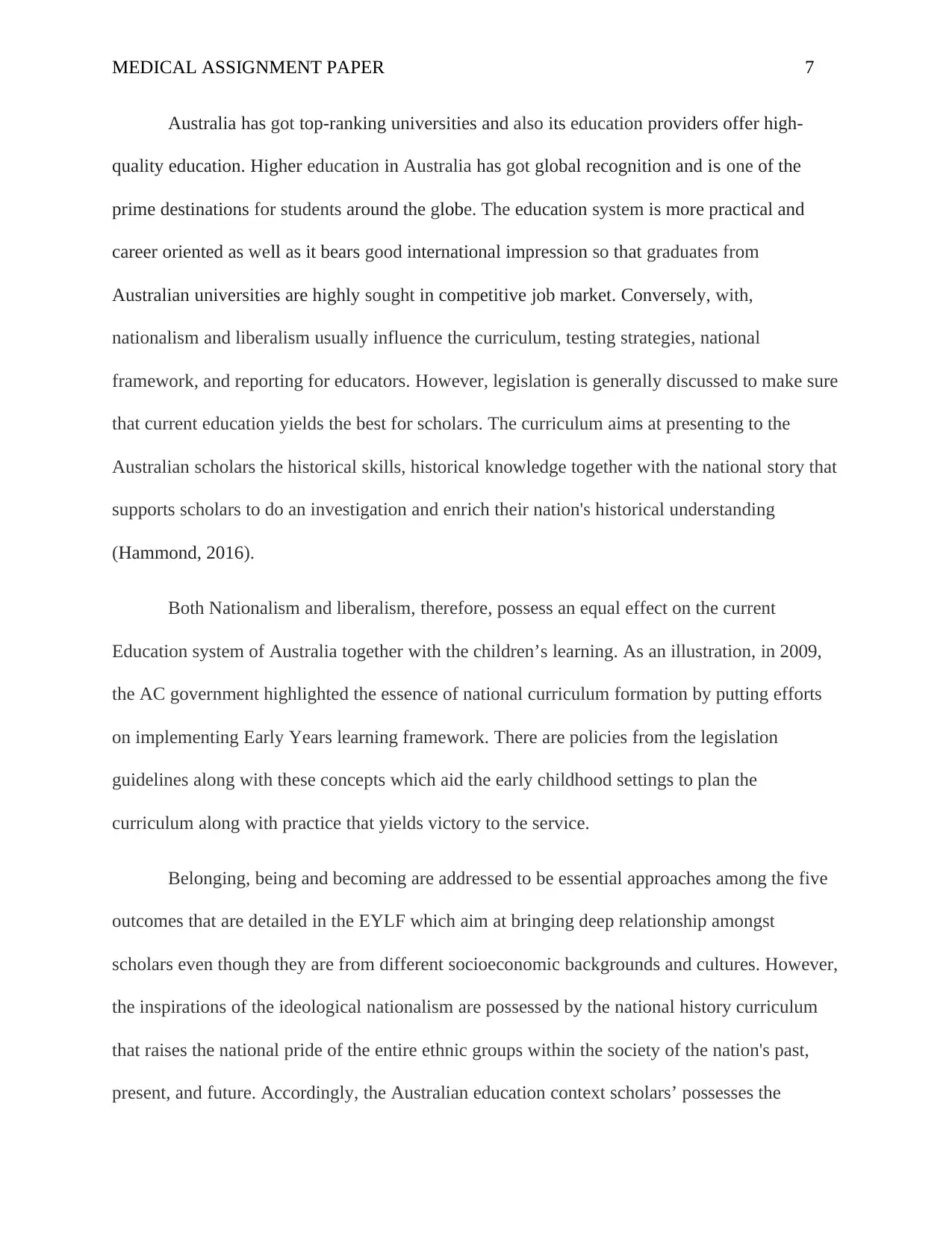
MEDICAL ASSIGNMENT PAPER 7
Australia has got top-ranking universities and also its education providers offer high-
quality education. Higher education in Australia has got global recognition and is one of the
prime destinations for students around the globe. The education system is more practical and
career oriented as well as it bears good international impression so that graduates from
Australian universities are highly sought in competitive job market. Conversely, with,
nationalism and liberalism usually influence the curriculum, testing strategies, national
framework, and reporting for educators. However, legislation is generally discussed to make sure
that current education yields the best for scholars. The curriculum aims at presenting to the
Australian scholars the historical skills, historical knowledge together with the national story that
supports scholars to do an investigation and enrich their nation's historical understanding
(Hammond, 2016).
Both Nationalism and liberalism, therefore, possess an equal effect on the current
Education system of Australia together with the children’s learning. As an illustration, in 2009,
the AC government highlighted the essence of national curriculum formation by putting efforts
on implementing Early Years learning framework. There are policies from the legislation
guidelines along with these concepts which aid the early childhood settings to plan the
curriculum along with practice that yields victory to the service.
Belonging, being and becoming are addressed to be essential approaches among the five
outcomes that are detailed in the EYLF which aim at bringing deep relationship amongst
scholars even though they are from different socioeconomic backgrounds and cultures. However,
the inspirations of the ideological nationalism are possessed by the national history curriculum
that raises the national pride of the entire ethnic groups within the society of the nation's past,
present, and future. Accordingly, the Australian education context scholars’ possesses the
Australia has got top-ranking universities and also its education providers offer high-
quality education. Higher education in Australia has got global recognition and is one of the
prime destinations for students around the globe. The education system is more practical and
career oriented as well as it bears good international impression so that graduates from
Australian universities are highly sought in competitive job market. Conversely, with,
nationalism and liberalism usually influence the curriculum, testing strategies, national
framework, and reporting for educators. However, legislation is generally discussed to make sure
that current education yields the best for scholars. The curriculum aims at presenting to the
Australian scholars the historical skills, historical knowledge together with the national story that
supports scholars to do an investigation and enrich their nation's historical understanding
(Hammond, 2016).
Both Nationalism and liberalism, therefore, possess an equal effect on the current
Education system of Australia together with the children’s learning. As an illustration, in 2009,
the AC government highlighted the essence of national curriculum formation by putting efforts
on implementing Early Years learning framework. There are policies from the legislation
guidelines along with these concepts which aid the early childhood settings to plan the
curriculum along with practice that yields victory to the service.
Belonging, being and becoming are addressed to be essential approaches among the five
outcomes that are detailed in the EYLF which aim at bringing deep relationship amongst
scholars even though they are from different socioeconomic backgrounds and cultures. However,
the inspirations of the ideological nationalism are possessed by the national history curriculum
that raises the national pride of the entire ethnic groups within the society of the nation's past,
present, and future. Accordingly, the Australian education context scholars’ possesses the
Paraphrase This Document
Need a fresh take? Get an instant paraphrase of this document with our AI Paraphraser
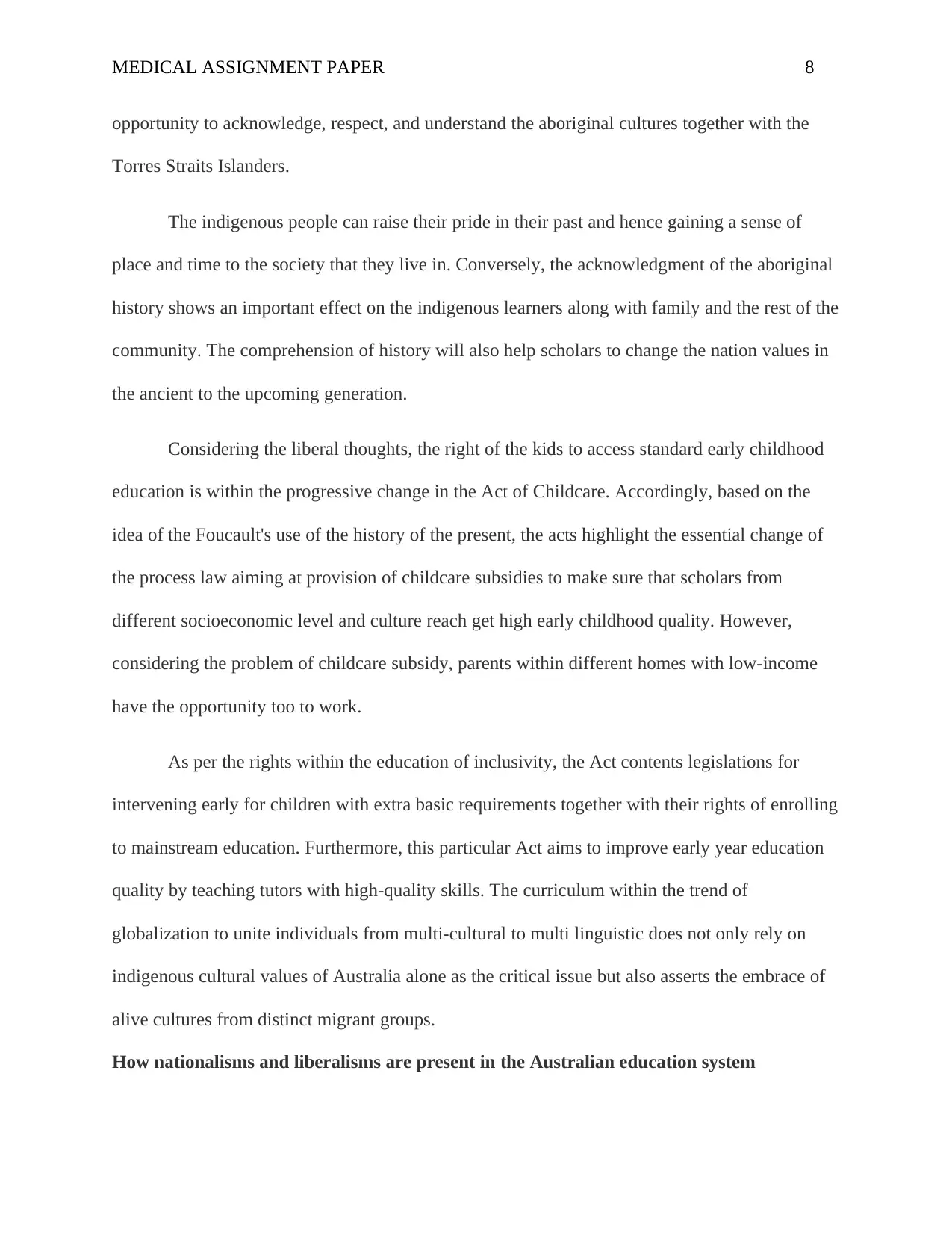
MEDICAL ASSIGNMENT PAPER 8
opportunity to acknowledge, respect, and understand the aboriginal cultures together with the
Torres Straits Islanders.
The indigenous people can raise their pride in their past and hence gaining a sense of
place and time to the society that they live in. Conversely, the acknowledgment of the aboriginal
history shows an important effect on the indigenous learners along with family and the rest of the
community. The comprehension of history will also help scholars to change the nation values in
the ancient to the upcoming generation.
Considering the liberal thoughts, the right of the kids to access standard early childhood
education is within the progressive change in the Act of Childcare. Accordingly, based on the
idea of the Foucault's use of the history of the present, the acts highlight the essential change of
the process law aiming at provision of childcare subsidies to make sure that scholars from
different socioeconomic level and culture reach get high early childhood quality. However,
considering the problem of childcare subsidy, parents within different homes with low-income
have the opportunity too to work.
As per the rights within the education of inclusivity, the Act contents legislations for
intervening early for children with extra basic requirements together with their rights of enrolling
to mainstream education. Furthermore, this particular Act aims to improve early year education
quality by teaching tutors with high-quality skills. The curriculum within the trend of
globalization to unite individuals from multi-cultural to multi linguistic does not only rely on
indigenous cultural values of Australia alone as the critical issue but also asserts the embrace of
alive cultures from distinct migrant groups.
How nationalisms and liberalisms are present in the Australian education system
opportunity to acknowledge, respect, and understand the aboriginal cultures together with the
Torres Straits Islanders.
The indigenous people can raise their pride in their past and hence gaining a sense of
place and time to the society that they live in. Conversely, the acknowledgment of the aboriginal
history shows an important effect on the indigenous learners along with family and the rest of the
community. The comprehension of history will also help scholars to change the nation values in
the ancient to the upcoming generation.
Considering the liberal thoughts, the right of the kids to access standard early childhood
education is within the progressive change in the Act of Childcare. Accordingly, based on the
idea of the Foucault's use of the history of the present, the acts highlight the essential change of
the process law aiming at provision of childcare subsidies to make sure that scholars from
different socioeconomic level and culture reach get high early childhood quality. However,
considering the problem of childcare subsidy, parents within different homes with low-income
have the opportunity too to work.
As per the rights within the education of inclusivity, the Act contents legislations for
intervening early for children with extra basic requirements together with their rights of enrolling
to mainstream education. Furthermore, this particular Act aims to improve early year education
quality by teaching tutors with high-quality skills. The curriculum within the trend of
globalization to unite individuals from multi-cultural to multi linguistic does not only rely on
indigenous cultural values of Australia alone as the critical issue but also asserts the embrace of
alive cultures from distinct migrant groups.
How nationalisms and liberalisms are present in the Australian education system
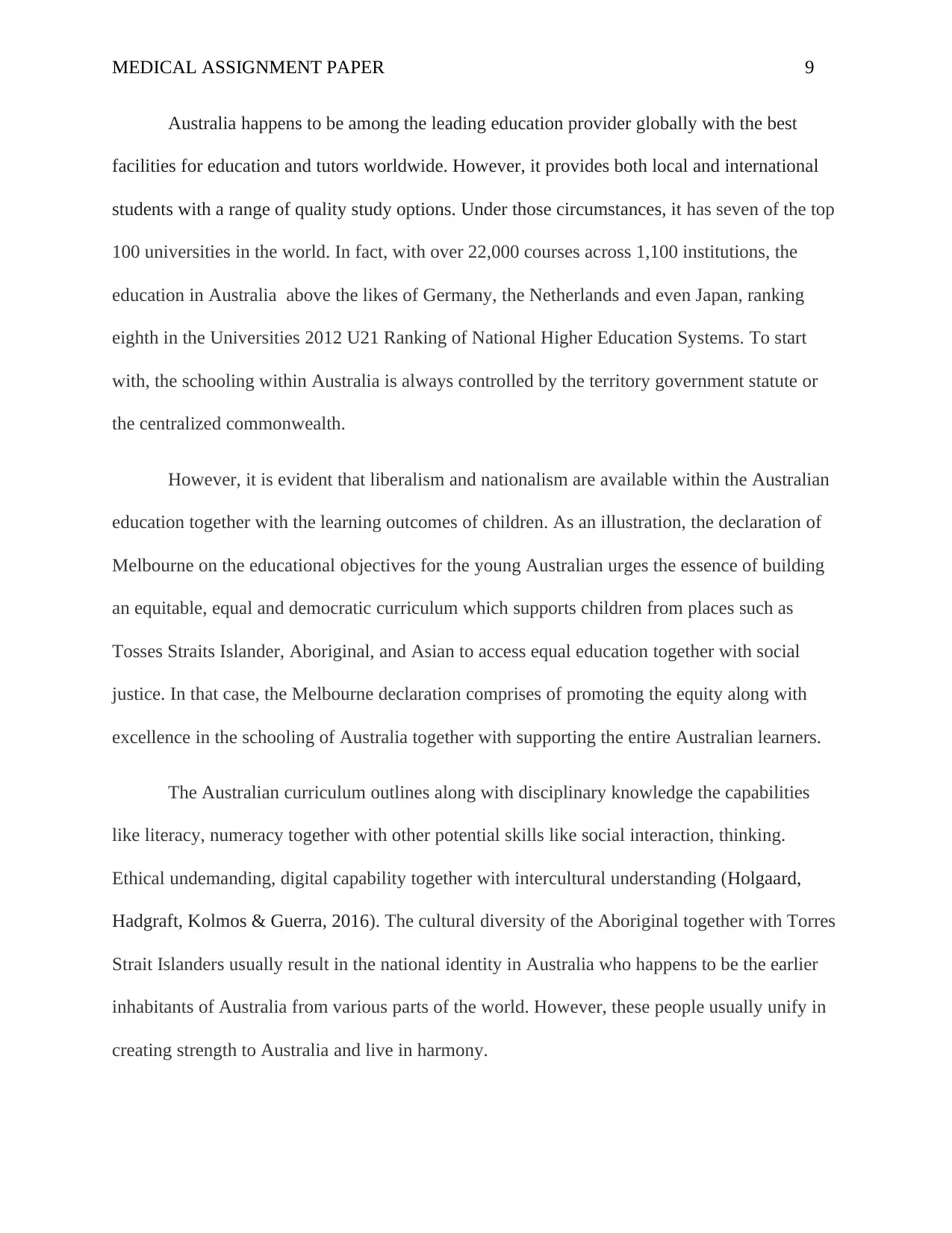
MEDICAL ASSIGNMENT PAPER 9
Australia happens to be among the leading education provider globally with the best
facilities for education and tutors worldwide. However, it provides both local and international
students with a range of quality study options. Under those circumstances, it has seven of the top
100 universities in the world. In fact, with over 22,000 courses across 1,100 institutions, the
education in Australia above the likes of Germany, the Netherlands and even Japan, ranking
eighth in the Universities 2012 U21 Ranking of National Higher Education Systems. To start
with, the schooling within Australia is always controlled by the territory government statute or
the centralized commonwealth.
However, it is evident that liberalism and nationalism are available within the Australian
education together with the learning outcomes of children. As an illustration, the declaration of
Melbourne on the educational objectives for the young Australian urges the essence of building
an equitable, equal and democratic curriculum which supports children from places such as
Tosses Straits Islander, Aboriginal, and Asian to access equal education together with social
justice. In that case, the Melbourne declaration comprises of promoting the equity along with
excellence in the schooling of Australia together with supporting the entire Australian learners.
The Australian curriculum outlines along with disciplinary knowledge the capabilities
like literacy, numeracy together with other potential skills like social interaction, thinking.
Ethical undemanding, digital capability together with intercultural understanding (Holgaard,
Hadgraft, Kolmos & Guerra, 2016). The cultural diversity of the Aboriginal together with Torres
Strait Islanders usually result in the national identity in Australia who happens to be the earlier
inhabitants of Australia from various parts of the world. However, these people usually unify in
creating strength to Australia and live in harmony.
Australia happens to be among the leading education provider globally with the best
facilities for education and tutors worldwide. However, it provides both local and international
students with a range of quality study options. Under those circumstances, it has seven of the top
100 universities in the world. In fact, with over 22,000 courses across 1,100 institutions, the
education in Australia above the likes of Germany, the Netherlands and even Japan, ranking
eighth in the Universities 2012 U21 Ranking of National Higher Education Systems. To start
with, the schooling within Australia is always controlled by the territory government statute or
the centralized commonwealth.
However, it is evident that liberalism and nationalism are available within the Australian
education together with the learning outcomes of children. As an illustration, the declaration of
Melbourne on the educational objectives for the young Australian urges the essence of building
an equitable, equal and democratic curriculum which supports children from places such as
Tosses Straits Islander, Aboriginal, and Asian to access equal education together with social
justice. In that case, the Melbourne declaration comprises of promoting the equity along with
excellence in the schooling of Australia together with supporting the entire Australian learners.
The Australian curriculum outlines along with disciplinary knowledge the capabilities
like literacy, numeracy together with other potential skills like social interaction, thinking.
Ethical undemanding, digital capability together with intercultural understanding (Holgaard,
Hadgraft, Kolmos & Guerra, 2016). The cultural diversity of the Aboriginal together with Torres
Strait Islanders usually result in the national identity in Australia who happens to be the earlier
inhabitants of Australia from various parts of the world. However, these people usually unify in
creating strength to Australia and live in harmony.
⊘ This is a preview!⊘
Do you want full access?
Subscribe today to unlock all pages.

Trusted by 1+ million students worldwide
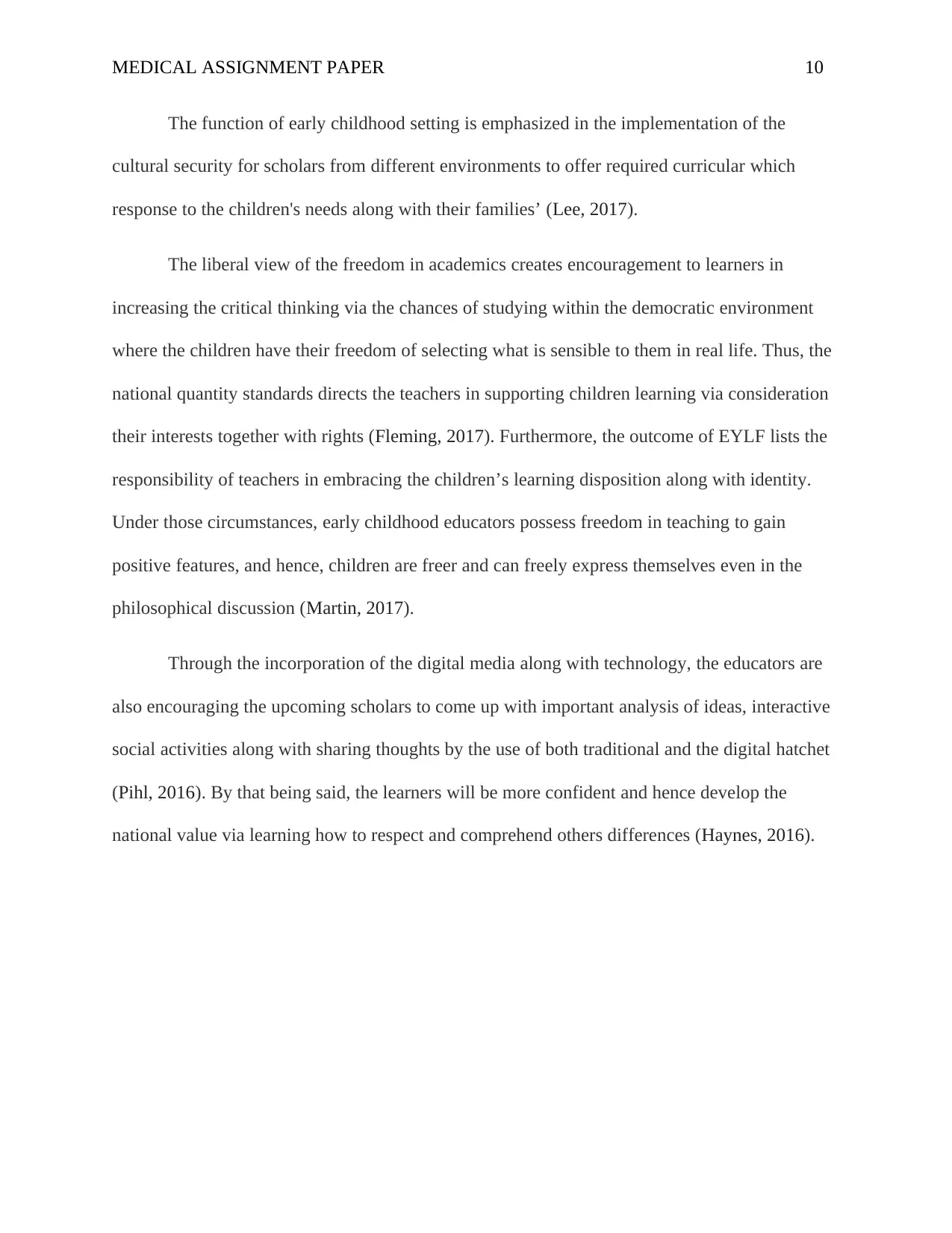
MEDICAL ASSIGNMENT PAPER 10
The function of early childhood setting is emphasized in the implementation of the
cultural security for scholars from different environments to offer required curricular which
response to the children's needs along with their families’ (Lee, 2017).
The liberal view of the freedom in academics creates encouragement to learners in
increasing the critical thinking via the chances of studying within the democratic environment
where the children have their freedom of selecting what is sensible to them in real life. Thus, the
national quantity standards directs the teachers in supporting children learning via consideration
their interests together with rights (Fleming, 2017). Furthermore, the outcome of EYLF lists the
responsibility of teachers in embracing the children’s learning disposition along with identity.
Under those circumstances, early childhood educators possess freedom in teaching to gain
positive features, and hence, children are freer and can freely express themselves even in the
philosophical discussion (Martin, 2017).
Through the incorporation of the digital media along with technology, the educators are
also encouraging the upcoming scholars to come up with important analysis of ideas, interactive
social activities along with sharing thoughts by the use of both traditional and the digital hatchet
(Pihl, 2016). By that being said, the learners will be more confident and hence develop the
national value via learning how to respect and comprehend others differences (Haynes, 2016).
The function of early childhood setting is emphasized in the implementation of the
cultural security for scholars from different environments to offer required curricular which
response to the children's needs along with their families’ (Lee, 2017).
The liberal view of the freedom in academics creates encouragement to learners in
increasing the critical thinking via the chances of studying within the democratic environment
where the children have their freedom of selecting what is sensible to them in real life. Thus, the
national quantity standards directs the teachers in supporting children learning via consideration
their interests together with rights (Fleming, 2017). Furthermore, the outcome of EYLF lists the
responsibility of teachers in embracing the children’s learning disposition along with identity.
Under those circumstances, early childhood educators possess freedom in teaching to gain
positive features, and hence, children are freer and can freely express themselves even in the
philosophical discussion (Martin, 2017).
Through the incorporation of the digital media along with technology, the educators are
also encouraging the upcoming scholars to come up with important analysis of ideas, interactive
social activities along with sharing thoughts by the use of both traditional and the digital hatchet
(Pihl, 2016). By that being said, the learners will be more confident and hence develop the
national value via learning how to respect and comprehend others differences (Haynes, 2016).
Paraphrase This Document
Need a fresh take? Get an instant paraphrase of this document with our AI Paraphraser
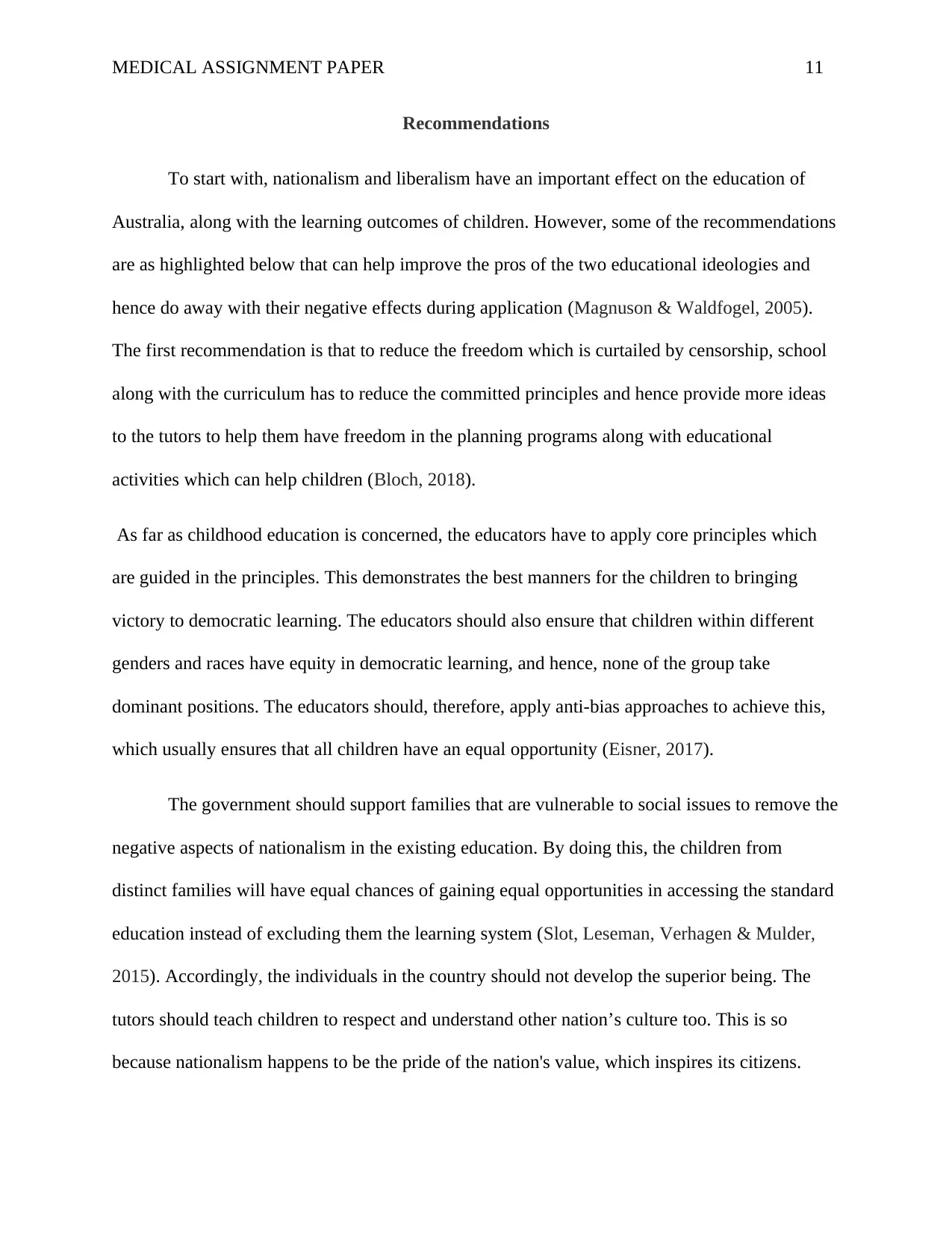
MEDICAL ASSIGNMENT PAPER 11
Recommendations
To start with, nationalism and liberalism have an important effect on the education of
Australia, along with the learning outcomes of children. However, some of the recommendations
are as highlighted below that can help improve the pros of the two educational ideologies and
hence do away with their negative effects during application (Magnuson & Waldfogel, 2005).
The first recommendation is that to reduce the freedom which is curtailed by censorship, school
along with the curriculum has to reduce the committed principles and hence provide more ideas
to the tutors to help them have freedom in the planning programs along with educational
activities which can help children (Bloch, 2018).
As far as childhood education is concerned, the educators have to apply core principles which
are guided in the principles. This demonstrates the best manners for the children to bringing
victory to democratic learning. The educators should also ensure that children within different
genders and races have equity in democratic learning, and hence, none of the group take
dominant positions. The educators should, therefore, apply anti-bias approaches to achieve this,
which usually ensures that all children have an equal opportunity (Eisner, 2017).
The government should support families that are vulnerable to social issues to remove the
negative aspects of nationalism in the existing education. By doing this, the children from
distinct families will have equal chances of gaining equal opportunities in accessing the standard
education instead of excluding them the learning system (Slot, Leseman, Verhagen & Mulder,
2015). Accordingly, the individuals in the country should not develop the superior being. The
tutors should teach children to respect and understand other nation’s culture too. This is so
because nationalism happens to be the pride of the nation's value, which inspires its citizens.
Recommendations
To start with, nationalism and liberalism have an important effect on the education of
Australia, along with the learning outcomes of children. However, some of the recommendations
are as highlighted below that can help improve the pros of the two educational ideologies and
hence do away with their negative effects during application (Magnuson & Waldfogel, 2005).
The first recommendation is that to reduce the freedom which is curtailed by censorship, school
along with the curriculum has to reduce the committed principles and hence provide more ideas
to the tutors to help them have freedom in the planning programs along with educational
activities which can help children (Bloch, 2018).
As far as childhood education is concerned, the educators have to apply core principles which
are guided in the principles. This demonstrates the best manners for the children to bringing
victory to democratic learning. The educators should also ensure that children within different
genders and races have equity in democratic learning, and hence, none of the group take
dominant positions. The educators should, therefore, apply anti-bias approaches to achieve this,
which usually ensures that all children have an equal opportunity (Eisner, 2017).
The government should support families that are vulnerable to social issues to remove the
negative aspects of nationalism in the existing education. By doing this, the children from
distinct families will have equal chances of gaining equal opportunities in accessing the standard
education instead of excluding them the learning system (Slot, Leseman, Verhagen & Mulder,
2015). Accordingly, the individuals in the country should not develop the superior being. The
tutors should teach children to respect and understand other nation’s culture too. This is so
because nationalism happens to be the pride of the nation's value, which inspires its citizens.
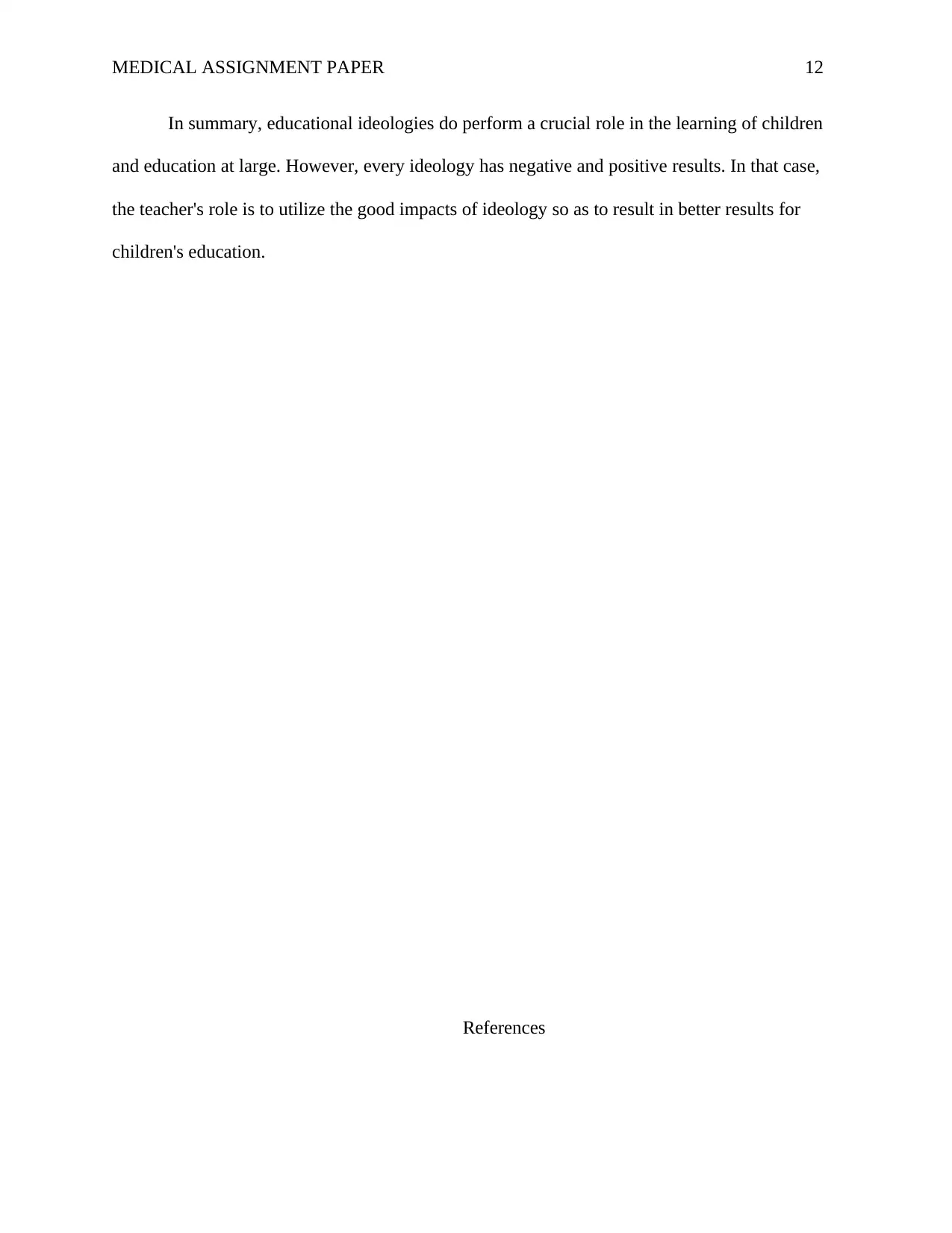
MEDICAL ASSIGNMENT PAPER 12
In summary, educational ideologies do perform a crucial role in the learning of children
and education at large. However, every ideology has negative and positive results. In that case,
the teacher's role is to utilize the good impacts of ideology so as to result in better results for
children's education.
References
In summary, educational ideologies do perform a crucial role in the learning of children
and education at large. However, every ideology has negative and positive results. In that case,
the teacher's role is to utilize the good impacts of ideology so as to result in better results for
children's education.
References
⊘ This is a preview!⊘
Do you want full access?
Subscribe today to unlock all pages.

Trusted by 1+ million students worldwide
1 out of 15
Related Documents
Your All-in-One AI-Powered Toolkit for Academic Success.
+13062052269
info@desklib.com
Available 24*7 on WhatsApp / Email
![[object Object]](/_next/static/media/star-bottom.7253800d.svg)
Unlock your academic potential
Copyright © 2020–2025 A2Z Services. All Rights Reserved. Developed and managed by ZUCOL.




